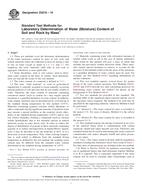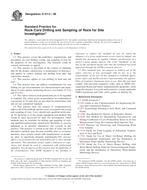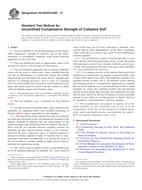Potřebujeme váš souhlas k využití jednotlivých dat, aby se vám mimo jiné mohly ukazovat informace týkající se vašich zájmů. Souhlas udělíte kliknutím na tlačítko „OK“.
ASTM D2216-10
Standard Test Methods for Laboratory Determination of Water (Moisture) Content of Soil and Rock by Mass
Automaticky přeložený název:
Standardní zkušební metody pro laboratorní stanovení obsahu vody (vlhkost) Obsah zemin a hornin podle hmotnosti
NORMA vydána dne 1.7.2010
Informace o normě:
Označení normy: ASTM D2216-10
Poznámka: NEPLATNÁ
Datum vydání normy: 1.7.2010
Kód zboží: NS-19640
Počet stran: 7
Přibližná hmotnost: 21 g (0.05 liber)
Země: Americká technická norma
Kategorie: Technické normy ASTM
Kategorie - podobné normy:
Zemní práce. Hloubicí práce. Budování základů. Podzemní práce
Anotace textu normy ASTM D2216-10 :
Keywords:
aggregate, consistency, index property, laboratory, moisture analysis, moisture content, soil, water content, Consistency, Earthwork, Embankments, Heating tests--soil/rock, Index property, Laboratory soil/rock analysis, Moisture analysis--soil/rock, Rock materials/properties/analysis, Soil-aggregate, Soil-moisture analysis, Underground environments, Water content--rock, Water content--soil, ICS Number Code 93.020 (Earth works. Excavations. Foundation construction. Underground works)
Doplňující informace
| Significance and Use | ||||||||||||||||||||||||||||
|
For many materials, the water content is one of the most significant index properties used in establishing a correlation between soil behavior and its index properties. The water content of a material is used in expressing the phase relationships of air, water, and solids in a given volume of material. In fine-grained (cohesive) soils, the consistency of a given soil type depends on its water content. The water content of a soil, along with its liquid and plastic limits as determined by Test Method D4318, is used to express its relative consistency or liquidity index. Note 2—The quality of the result produced by this standard is dependent on the competence of the personnel performing it, and the suitability of the equipment and facilities used. Agencies that meet the criteria of Practice D3740 are generally considered capable of competent and objective testing/sampling/inspection/etc. Users of this standard are cautioned that compliance with Practice D3740 does not in itself ensure reliable results. Reliable results depend on many factors; Practice D3740 provides a means of evaluating some of those factors. |
||||||||||||||||||||||||||||
| 1. Scope | ||||||||||||||||||||||||||||
|
1.1 These test methods cover the laboratory determination of the water (moisture) content by mass of soil, rock, and similar materials where the reduction in mass by drying is due to loss of water except as noted in 1.4, 1.5, and 1.7. For simplicity, the word “material” shall refer to soil, rock or aggregate whichever is most applicable. 1.2 Some disciplines, such as soil science, need to determine water content on the basis of volume. Such determinations are beyond the scope of this test method. 1.3 The water content of a material is defined in 3.2.1. 1.4 The term “solid material” as used in geotechnical engineering is typically assumed to mean naturally occurring mineral particles of soil and rock that are not readily soluble in water. Therefore, the water content of materials containing extraneous matter (such as cement etc.) may require special treatment or a qualified definition of water content. In addition, some organic materials may be decomposed by oven drying at the standard drying temperature for this method (110°C). Materials containing gypsum (calcium sulfate dihydrate) or other compounds having significant amounts of hydrated water may present a special problem as this material slowly dehydrates at the standard drying temperature (110°C) and at very low relative humidity, forming a compound (such as calcium sulfate hemihydrate) that is not normally present in natural materials except in some desert soils. In order to reduce the degree of dehydration of gypsum in those materials containing gypsum or to reduce decomposition in highly/fibrous organic soils, it may be desirable to dry the materials at 60°C or in a desiccator at room temperature. Thus, when a drying temperature is used which is different from the standard drying temperature as defined by this test method, the resulting water content may be different from the standard water content determined at the standard drying temperature of 110°C. Note 1—Test Method D2974 provides an alternate procedure for determining water content of peat materials. 1.5 Materials containing water with substantial amounts of soluble solids (such as salt in the case of marine sediments) when tested by this method will give a mass of solids that includes the previously soluble dissolved solids. These materials require special treatment to remove or account for the presence of precipitated solids in the dry mass of the specimen, or a qualified definition of water content must be used. For example, see Test Method D4542 regarding information on marine sediments. 1.6 This test standard requires several hours for proper drying of the water content specimen. Test Methods D4643, D4944 and D4959 provide less time-consuming processes for determining water content. See Gilbert for details on the background of Test Method D4643. 1.7 Two test methods are provided in this standard. The methods differ in the significant digits reported and the size of the specimen (mass) required. The method to be used may be specified by the requesting authority; otherwise Method A shall be performed. 1.7.1 Method A—The water content by mass is recorded to the nearest 1 %. For cases of dispute, Method A is the referee method. 1.7.2 Method B—The water content by mass is recorded to the nearest 0.1 %. 1.8 This standard requires the drying of material in an oven. If the material being dried is contaminated with certain chemicals, health and safety hazards can exist. Therefore, this standard should not be used in determining the water content of contaminated soils unless adequate health and safety precautions are taken. 1.9 Units—The values stated in SI units shall be regarded as standard excluding the Alternative Sieve Sizes listed in Table 1. No other units of measurement are included in this test method. 1.10 Refer to Practice D6026 for guidance concerning the use of significant figures that shall determine whether Method, A or B is required. This is especially important if the water content will be used to calculate other relationships such as moist mass to dry mass or vice versa, wet unit weight to dry unit weight or vice versa, and total density to dry density or vice versa. For example, if four significant digits are required in any of the above calculations, then the water content must be recorded to the nearest 0.1 %. This occurs since 1 plus the water content (not in percent) will have four significant digits regardless of what the value of the water content is; that is, 1 plus 0.1/100 = 1.001, a value with four significant digits. While, if three significant digits are acceptable, then the water content can be recorded to the nearest 1 %. 1.11 This standard does not purport to address all of the safety concerns, if any, associated with its use. It is the responsibility of the user of this standard to establish appropriate safety and health practices and determine the applicability of regulatory limitations prior to use. |
||||||||||||||||||||||||||||
| 2. Referenced Documents | ||||||||||||||||||||||||||||
|
Podobné normy:
Historická
1.10.2008
Historická
15.5.2013
Historická
1.4.2008
Historická
1.6.2014
Historická
1.2.2006
Historická
1.5.2011



 ASTM D2113-08
ASTM D2113-08 ASTM D2166/D2166M-13..
ASTM D2166/D2166M-13.. ASTM D2167-08
ASTM D2167-08 ASTM D2419-14
ASTM D2419-14 ASTM D2434-68(2006)..
ASTM D2434-68(2006).. ASTM D2435/D2435M-11..
ASTM D2435/D2435M-11..
 Cookies
Cookies
